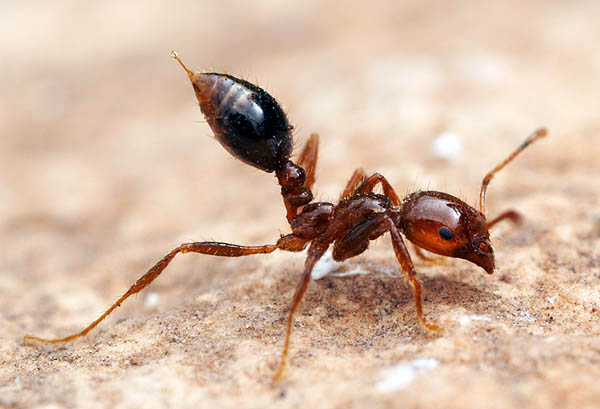
When invasive fire ants (Solenopsis invicta) were first discovered in the United States, scientists observed that their colonies each had a single queen, and that the ants were extremely aggressive toward individuals that immigrated from other colonies. However, they soon found that certain S. invicta colonies have multiple queens and even tend to adopt queens from other colonies. It turned out that different forms of a single gene, called Gp-9, determine a particular colony’s social system.
Now, scientists studying this gene have found that Gp-9 is part of a “supergene” that controls a large suite of traits related to sociality, and the chromosomes carrying this supergene behave a lot like sex chromosomes. Their research was published this week in Nature.
The Gp-9 gene determines whether S. invicta colonies will accept one queen or more; colonies composed of ants that are homozygous for one form of this gene will tolerate only one queen, while colonies that include heterozygous ants will tolerate multiple matriarchs. Gp-9 codes for an oderant-binding protein; these proteins specialize in helping pheromones and other odor molecules get from the environment to an animal’s olfactory receptors. It is likely, therefore, that chemical communication regulates the number of queens that are accepted into a colony.
But the two types of colonies differ in all sorts of other ways—aggressive behavior, colony initiation methods, and sperm production—that don’t depend on olfaction. This led researchers to wonder whether Gp-9 is part of a “supergene,” a complex of tightly linked genes that coordinate a suite of characteristics and behaviors.
They were right: social behavior in this species does appear to be linked to a supergene. It turns out that there is limited recombination (a form of genetic shuffling) between the pair of chromosomes that carry the two copies of Gp-9. This allows genes that are adaptive for a particular social system to accumulate together on a single chromosome. Because it's so advantageous, genes that confer benefits to a multiple-queen colony end up closely linked to the form of Gp-9 that controls this behavior.
The multiple-queen social chromosome was called Sb. Recombination with the single-queen chromosome, called SB, is severely limited in order to preserve this adaptive combination of traits.
It’s similar to the way that sex-specific traits are linked on a sex chromosome; in many species, genes that code for traits that are beneficial for males cozy up together on the Y chromosome. Recombination between X and Y chromosomes isn’t adaptive, since males would lose these adaptive traits (and females could potentially be harmed by them).
The S. invicta Sb chromosome and the human Y chromosome are also similar in another way. Due to reduced recombination, they are more likely to accumulate mildly deleterious changes, such as repetitive elements and longer introns. However, thanks to the existence of haploid S. invicta males (males with a single set of chromosomes), deleterious mutations on the fire ant social chromosome experience some degree of selection, and the number of deleterious mutations may be minimized.
Four of 12 species of fire ant have multiple social systems, and this chromosomal arrangement appears in all four species. Phylogenetic analyses suggest that rather than evolving independently multiple times, this social chromosome system probably only evolved once, about 390,000 years ago, before these species diverged.
This is the first study to describe a social chromosome, and the first to link supergenes and behavior. However, the authors think it’s likely that this type of arrangement exists in several species, especially other social insects. The work makes a nice addition to the recent study on mouse behavior in terms of identifying how genetic changes can drive complex traits.
Nature, 2013. DOI: 10.1038/nature11832 (About DOIs).
reader comments
14